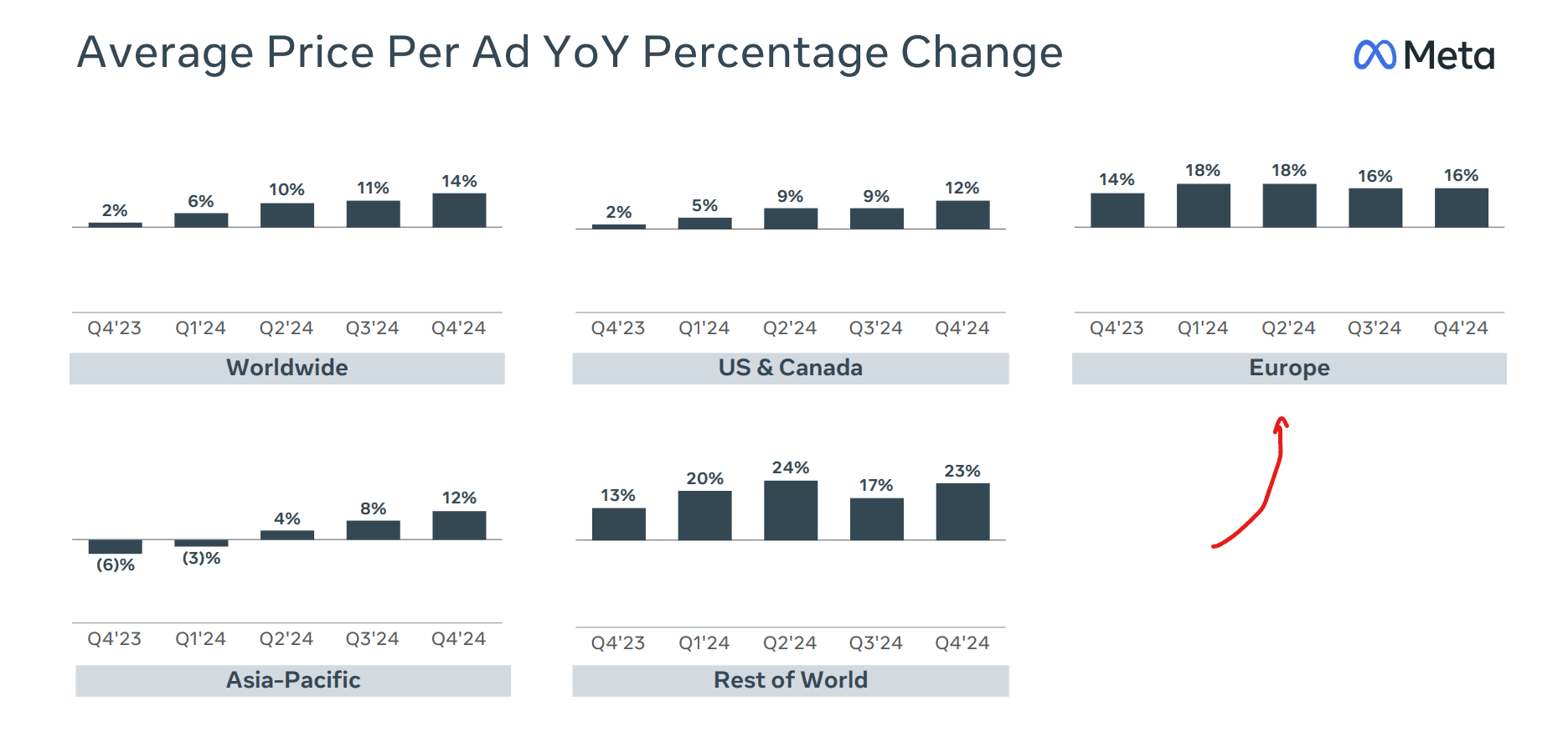If your charity relies on Meta ads to attract donations, fundraisers, legacy giving leads, or campaign supporters, you’ve probably already felt the impact of rising advertising costs.
Meta’s Q4 2024 earnings report (a dry read, I promise you!) revealed a 16% increase in the average cost per ad served in Europe. In Q4 2023, that was 14%, so assuming the trend continues, charities could reasonably expect a further 10-15% rise in 2025. That means your cost-per-acquisition (CPA) will increase (and your ROI will fall) unless you improve conversion rates (CVR).


Simply put:
If your CPM rises by 16%, you need to increase conversion rates by at least 16% just to keep your results the same 💡
For charities, this isn’t just a budget issue—it’s a threat to supporter engagement and fundraising efficiency. Rather than spending your way out of the problem with bigger media budgets or increased creative production, the smarter approach is to instigate Conversion Rate Optimisation (CRO) first.
what is CRO and why does it matter for charities?
CRO is about making your website, donation pages (and funnels), and sign-up forms work harder. Rather than just driving more traffic, you’re ensuring more of your visitors complete the desired action—whether that’s making a donation, signing up for an event, or pledging a gift in a Will.
With rising ad costs, even a small increase in conversion rate (CVR) can have a massive impact on ROI. As an example:
If your current donation page converts at 3%, and Meta costs rise by 15%, you’ll need to increase CVR to 3.45% just to maintain efficiency 📈
Stakeholder engagement and frameworks
To successfully implement CRO, cross-discipline collaboration is key. CRO requires input from multiple skillsets, including digital marketers, fundraisers, web developers, UX designers, data analysts, and leadership teams.
A structured approach ensures everyone is aligned on goals, priorities, and KPIs. Establishing clear processes for testing, measuring, and iterating helps create a culture of continuous improvement. By integrating CRO into broader digital strategies, charities can build scalable, repeatable frameworks that drive sustainable growth.
3 CRO tactics to protect your fundraising and campaign goals
1. Reduce friction on your donation & sign-up pages
- Ensure a seamless experience (especially mobile, most charity ad traffic comes from mobile users). Actually go and use your website, or even better ask a close friend or family member to do it too - you’ll be surprised at the obvious blockers that might be lurking.
- Cut unnecessary form fields—only ask for the essentials.
- Offer express checkout options (Apple Pay, PayPal, Google Pay) for faster donations.
- Use real-time validation to prevent errors and user frustration.
Charities that streamline donation forms see a 20-50% increase in completion rates.
2. Improve message match between ads & landing pages
- Make sure landing pages reflect ad messaging to maintain donor trust.
- Personalise donation asks based on audience segments (e.g., first-time vs. returning donors).
- Highlight impact-driven messaging—show how each donation makes a tangible difference. Review your storytelling and impact stories. Studies repeatedly show that storytelling is more likely to drive supporter action than pure stats and figures.
Meta’s ad algorithm prioritises relevant experiences—better alignment means lower CPCs and better ad performance.
3. Use AI & personalisation for smarter CRO
- Investigate emerging AI-powered donation forms that suggest giving amounts based on user behaviour.
- Use heatmaps & session recordings to identify drop-off points and optimise page layouts. Hotjar has a free version to get started, but make sure your consent banners/policies are implemented correctly.
- Test nudge tools, such as progress bars for appeals or most common/recent donations tickers
- Implement dynamic content that adjusts based on visitor type (e.g., regular donors vs. one-time givers).
A/B testing personalised donation pages can boost conversions by 30-40%.
what charity marketers should do now
-
Assume another 10-15% rise in Meta costs for 2025. Review budgets, forecasts and models (or reach out to us to help you build these if you don't already have them!), and update targets/projections.
-
Start conversations with senior budget holders. Investing in CRO now could deliver significantly better ROI than simply increasing media spend, or developing lots of new ads.
-
Set expectations. Bring people around you on this journey - your organisation needs to be able to embrace the power of failure - 80% of AB tests might have no winner and that's OK - learning what doesn’t work is just as important as learning what does.
-
Pilot small CRO experiments. Even small changes—like reducing form fields or improving page speed—can yield major improvements in conversion rates.
-
Benchmark. Capture what your conversion rates are like before you make a start, it’s nice to be able to show the impact of any ideas you’ve had and changes you might make.
Ready to future-proof your fundraising?
Instead of struggling with rising CPAs and declining efficiency, a strategic CRO investment can help your charity achieve more with less.
If you want expert help optimising your donation and registration journeys, then let’s chat.
Further reading
-
If your charity’s Meta ads account has been affected by the recent restrictions based on sensitive content, take a look at our Digital Marketing Director’s thoughts in this area, and actions you can be thinking about now.
-
We implemented a structured programme of CRO with our client Woodgreen Pets Charity to bring about a 62% increase in their Meta ad traffic in just 4 months, find out more about that project here: Woodgreen case study
